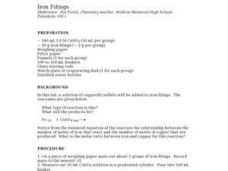Curated OER
Balancing Chemical Equations
Ninth graders explain how atoms and molecules form different substances during chemical reactions and how these processes require losing, gaining or sharing electrons. They correctly write chemical formulas and show how a balanced...
Curated OER
Precipitation and Neutralization Reactions
In this chemical reactions worksheet, students determine the balanced formula equation, balanced complete ionic equation, and the balanced net ionic equation for given reactions. Students calculate final concentrations for ions in given...
Curated OER
How Are The Properties of Covalent Compounds Influenced By Chemical Bonding?
Students work together to observe the bond lengths of single, double and triple bonds. They make their own predictions about the strength of the bonds and chemical reactions. They answer discussion questions to complete the...
Virginia Department of Education
Mystery Iron Ions
Young chemists perform an experiment to determine if a compound is iron (II) chloride or iron (III) chloride. Then they determine the formula, balance the equation, and answer analysis questions.
Curated OER
Physical or Chemical- That Is the Question!
Students differentiate physical and chemical changes. In this chemistry activity, students give examples of each type of change. They take the review quiz at the end of the activity.
Curated OER
Playing With Polymers
Students explore the world of polymers. In this chemistry lesson, students make polymers and observe their properties. Follow-up questions and extension activities are included.
Chicago Botanic Garden
Are All Plants Created Equal?
Photosynthesis requires energy and produces food, and cellular respiration produces energy and requires food. An interesting lesson plan analyzes the factors that affect the rates of photosynthesis and respiration. Classes spend one day...
Curated OER
Chemical Leavening Agents
Discuss leavening agents and baked goods. Describe the purpose of leavening agents in baked goods List the four major leavening agents Explain why baking soda is used with an acid in baked goods Identify the types of doughs and batters...
Curated OER
Iron Filings
Students conduct an experiment in which a solution of copper(II) sulfate is added to iron filings. They write and balance the equation for the reaction that occurs and calculate the amount of iron that reacted and the percent yield of...
Curated OER
Physical and Chemical Changes
Sixth graders complete several experiments about chemical and physical changes. In this physical and chemical science lesson, 6th graders complete 6 experiments about chemical and physical changes. Students examine the processes of...
Curated OER
A Never-ending Story
Learners identify three main types of rocks found in a rocks and sediments booklet. Students identify and interpret the rock cycle to use in the activity. Learners identify and classify rocks into the correct rock group. Students draw...
Curated OER
Addition Polymerization: Preparation of Polystyrene Using Two Types of Initiators
Advanced chemistry classes compare the polymerization of styrene using two different initators: benzoyl peroxide and aluminum chloride. Once they synthesize polystyrene, they compare the two producet for melting point and density. There...
Cornell University
What Is Rust?
Why do metals rust differently? Scholars experiment with metal combinations in a hands-on activity. They create unique environments with different metals and compare the rate and amount of rust for each.
Science Matters
Forms of Energy
The amount of energy Americans use doubles every 20 years. The first lesson in a 10-part series teaches scholars about different forms of energy. They rotate through five stations with hands-on activities or experiments at each in order...
Curated OER
Observation and Stimulation of bioluminescence and chemiluminescence
Students are introduced to chemical reactions, reaction rates, chemiluminescence, fluorescence and bioluminescence. They use glow sticks are used to demonstrate the effect of temperature on the rates of chemical reactions. Pupils recall...
Curated OER
Crazy Chemistry Lesson Plan
Young scholars study water molecules, cohesion and surface tension. In this molecule cohesion lesson students create chemical reactions that cause a balloon to inflate and another one that results in soap suds.
Curated OER
Yeast Fermentation
Students measure the temperature change involved in the production of carbon dioxide by yeast. They also identify products and reactants in a chemical and balance the equation.
Curated OER
Explosives
Pupils assume the role of police detectives and investigate chemical agents used to make explosives and suspected terrorists based on information provided. Students have a list of questions to lead their investigation and must produce...
Curated OER
Micro-Reaction Lab: Gas Prouducing Reactions
High schoolers investigate single displacement or double displacement reactions. They have to identify the type of gas produced by filling in the blanks to a data and observation sheet. Also, having to be done is writing balanced...
Curated OER
Chemical Bonding
Eighth graders identify the three main types of chemical bonds. In this chemistry lesson plan, 8th graders draw Lewis dot diagrams of elements and determine the bond formed. They create a model water molecule.
Curated OER
Chemical Equilibrium
Students explore Le Chatelier's Principle. In this lesson about chemical equilibrium, students do an experiment with several different activities . Students observe as they do the experiments and understand the outcome. Students become...
Curated OER
Elements and Compounds
Eighth graders explore the chemical and physical properties of a variety of elements in a lab setting. They organize the data they collect onto a spreadsheet and then choose one element from the periodic table to research. They...
Curated OER
How Do Car Engines Work?
Students perform an experiment which simulates what happens inside an internal combustion engine. They explain how the chemical reaction they witnessed is similar to what happens inside the car engine.
Curated OER
Daniell Cell
Young scholars explain how Daniell cells work. In this electrochemistry instructional activity, students conduct a variety of experiments to explore the different types of cells. They create a model of Daniell cell.

























